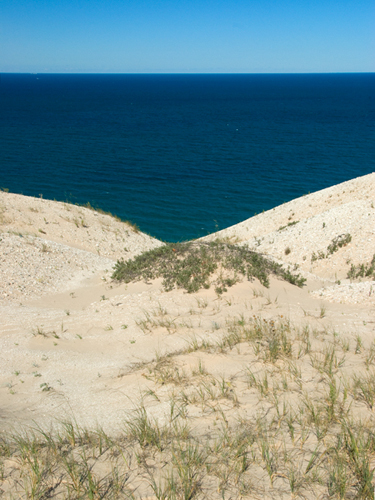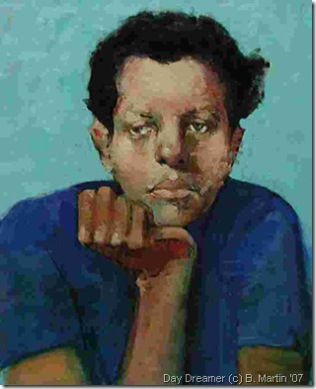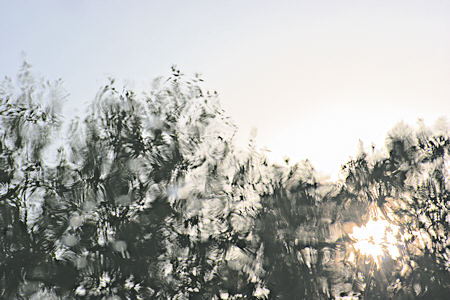Posted by Steve Durbin on September 8th, 2007
We have been discussing the correction of distortions that can arise when photographing paintings, doorways and such. One solution is found in Photoshop where a mode in the cropping tool can be used to square up images taken from oblique angles.
This mode, meant primarily to rectify, can also be used to distort. That which is already head-on can be given an oblique perspective.
This is an example using one of Tree’s houses. Here we see the image as she posted it.
more… »
Posted by Birgit Zipser on September 7th, 2007

Keystoning or the distortion of vertical lines was a concern last year when I photographed paintings. On dpreview.com, I learned that to avoid keystoning one should hold the camera on a parallel plane to a painting and then shoot at the longest zoom setting. more… »
Posted by Bob Martin on September 6th, 2007
 This is the end product of a demo I posted on another site. The process I used was to do a series of acrylic washes until I thought I knew the person I was looking for in this painting. Then started to build in oil, leaving some of the acrylic visible. I kept from moving away from my original idea by avoiding the urge to make everything perfect. I thought about making the hand smaller or detailing the neck line of his T-Shirt, but it remained just a thought. I had the feeling that I was done and it was time to move on to something new.
This is the end product of a demo I posted on another site. The process I used was to do a series of acrylic washes until I thought I knew the person I was looking for in this painting. Then started to build in oil, leaving some of the acrylic visible. I kept from moving away from my original idea by avoiding the urge to make everything perfect. I thought about making the hand smaller or detailing the neck line of his T-Shirt, but it remained just a thought. I had the feeling that I was done and it was time to move on to something new.
Posted by Steve Durbin on September 4th, 2007

Last week, on my way to somewhere else, I spent a little time wandering in a park and happened on the scene you see above. As you may guess, it is a reflection of trees in a slow-moving stream, which I inverted to present to you as a painterly dreamscape.
A moment later, from the same position, I made the following photograph of the same subject. If the first conjures a dreamy impression, the second may make you rather think nightmare. Why are they so different?
more… »
Posted by Karl Zipser on September 3rd, 2007

Painting
From Life vs.
From Photos
 I first posted this interview a year ago. Dan Bodner has continued with this work. A follow-up interview will appear soon.
I first posted this interview a year ago. Dan Bodner has continued with this work. A follow-up interview will appear soon.
To paint from a photograph is inherently different than painting from life. Some artists avoid photos, others use them, perhaps covertly, for practical reasons. But to American artist Dan Bodner, painting from photos is not merely a technique, but a way to focus on his role as an artist. I interviewed Bodner at his studio in Amsterdam.
Question: When you work from photographs, do you ever ask yourself, what is the point of making the painting, when the image already exists in the photo?
Bodner: No. A photo is a record of a moment that has passed, a dead moment. I don’t feel that I own the image as a photograph until I paint it as a painting. The photo itself always refers to the past. But a painting of the photo is a creation, which goes on living. The painting defines its own continuing moment in time.
Question: Does painting go beyond the goal of simply making an image?
Bodner: What painting is for me is part of human desire. Every kid smears his food, or shit, and that is really connected to what painting is. A kid makes a mark and has the satisfaction of knowing “I made this and it will stay there.” For an adult I think it is connected to fear of death, which is innate. And it is connected to the desire to procreate. As you get older it gets existential, of course. To take things out of you and put them into the world, there is an absolute satisfaction in that. To do this from a photo emphasizes the act of creation, bringing life to something dead.
____
In the next post more about how Dan Bodner uses photos, his subjects and his methods
Posted by June Underwood on August 31st, 2007
I’m just back from a pleine aire, oil painting workshop and it seems that my topic — to paint in the middle in the muddle or to recollect in tranquility — has arisen again on A&P. Hi Sunil…..
Obviously I’m fascinated with the immediate ambiance as much as I am with the final product. The milieu from which I just returned, however, had its problems. The big one was the lack of focus within the landscapes we were asked to paint. So the topic of the day is — how do you find your viewpoints and hold them? more… »
Posted by Sunil Gangadharan on August 30th, 2007
Karl recently mentioned here that he prefers (and revels) painting in the context of his reaction to his surroundings. He averred to say that a photo of the landscape would not do justice because
“Photographs record what a place looked like at a particular moment. They don’t record what it felt like to be there”
My personal experience is a little different. more… »




